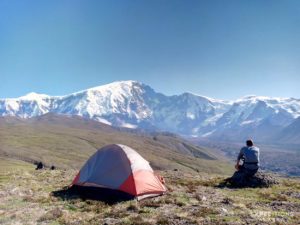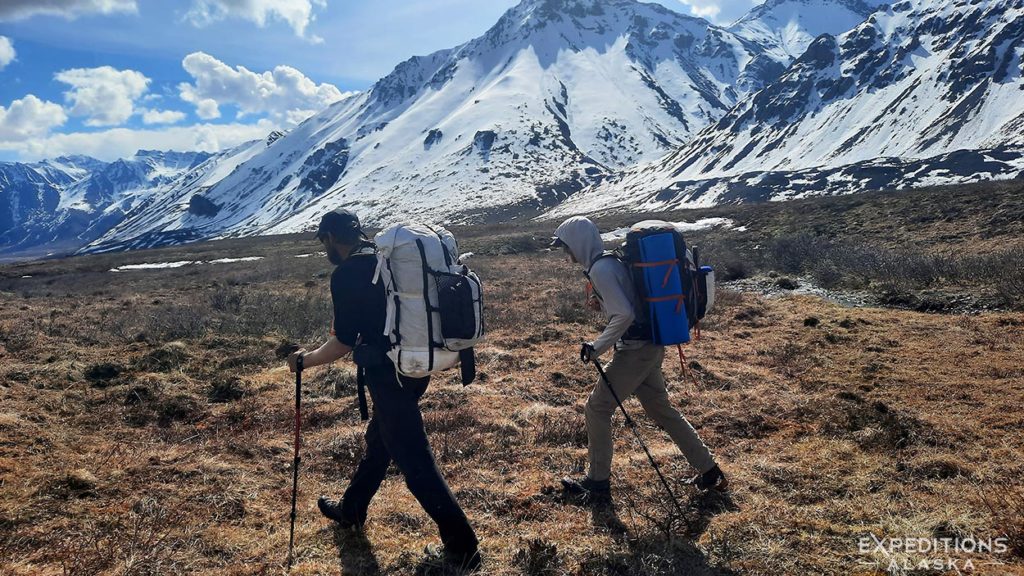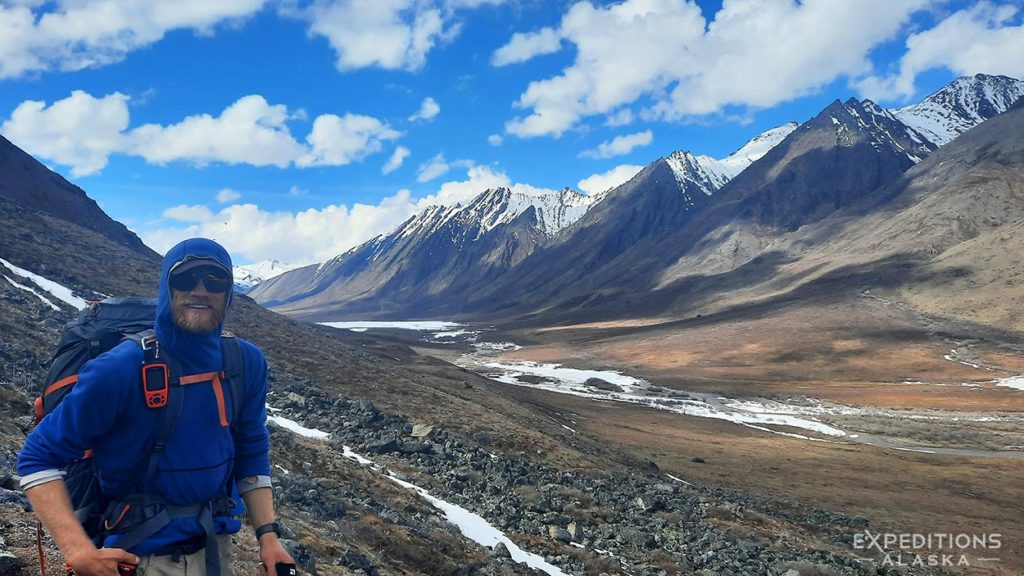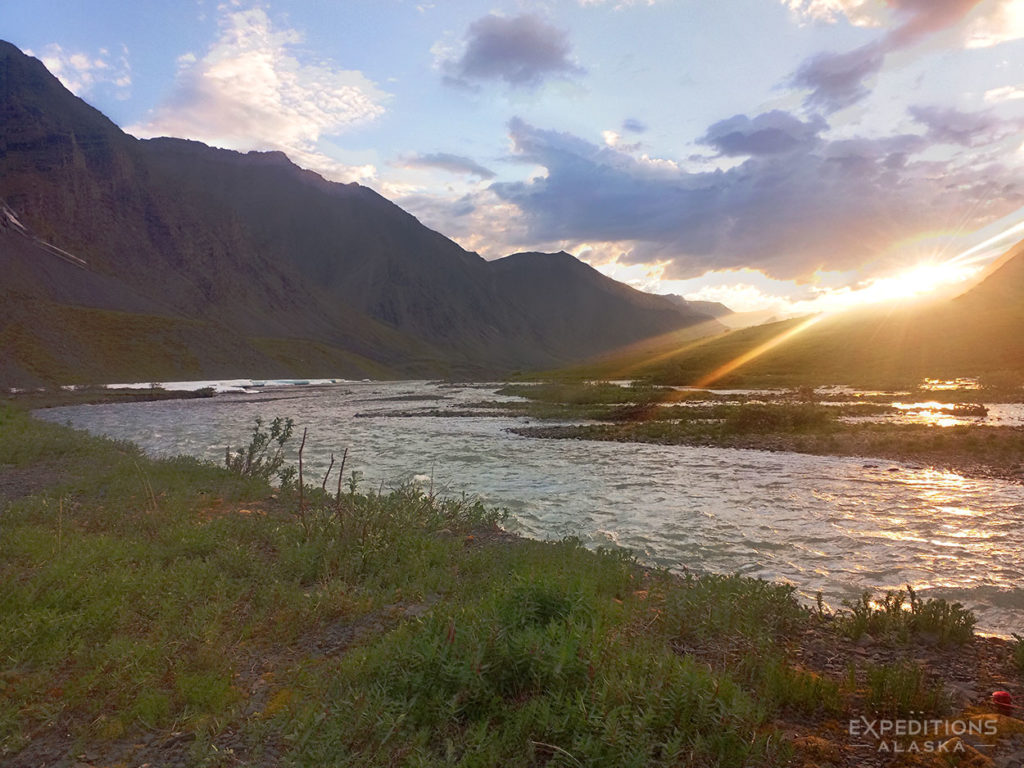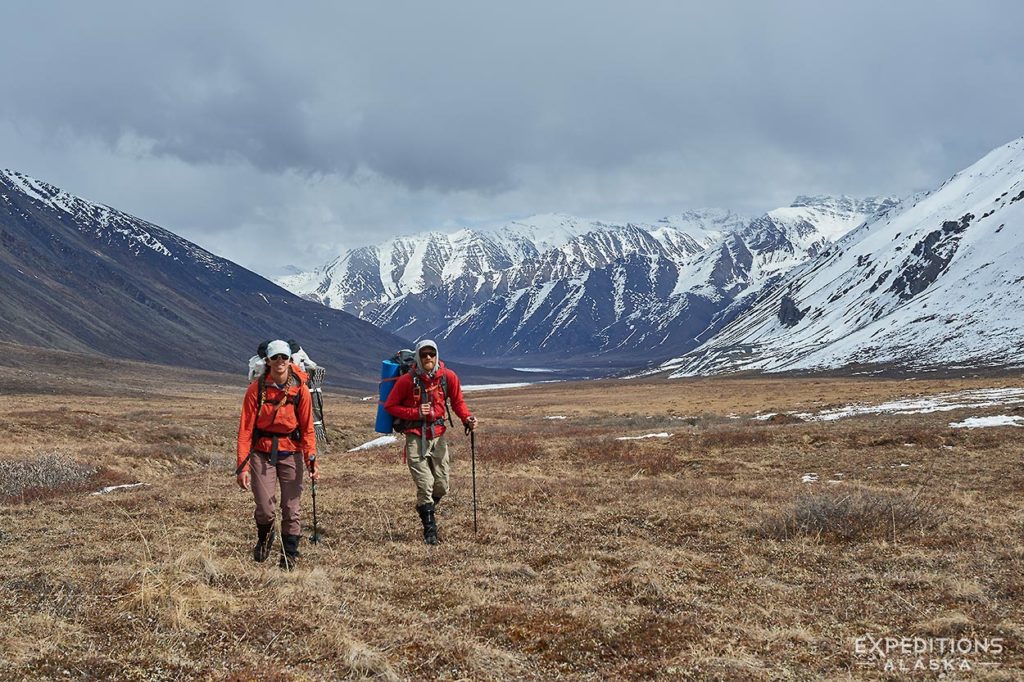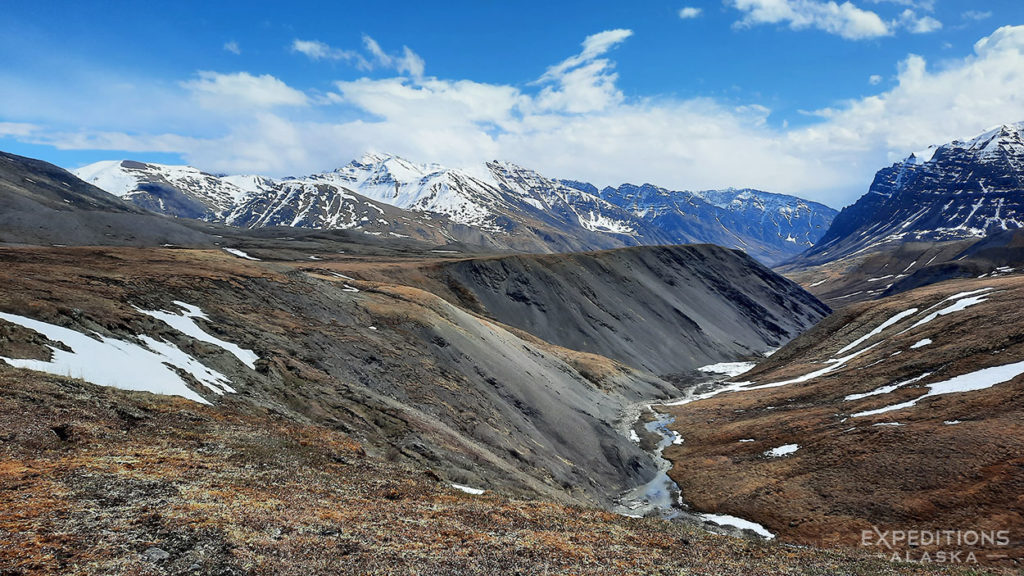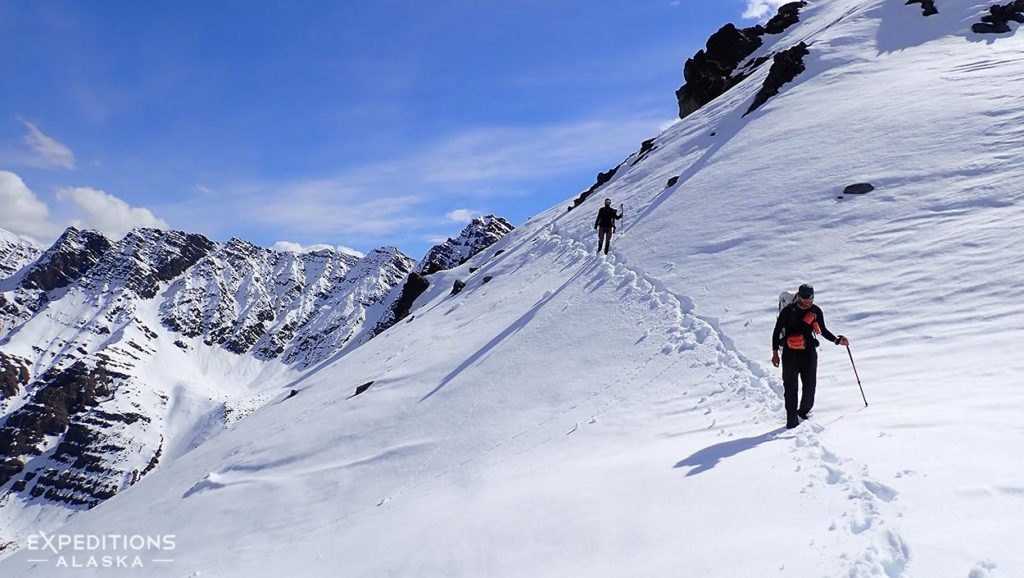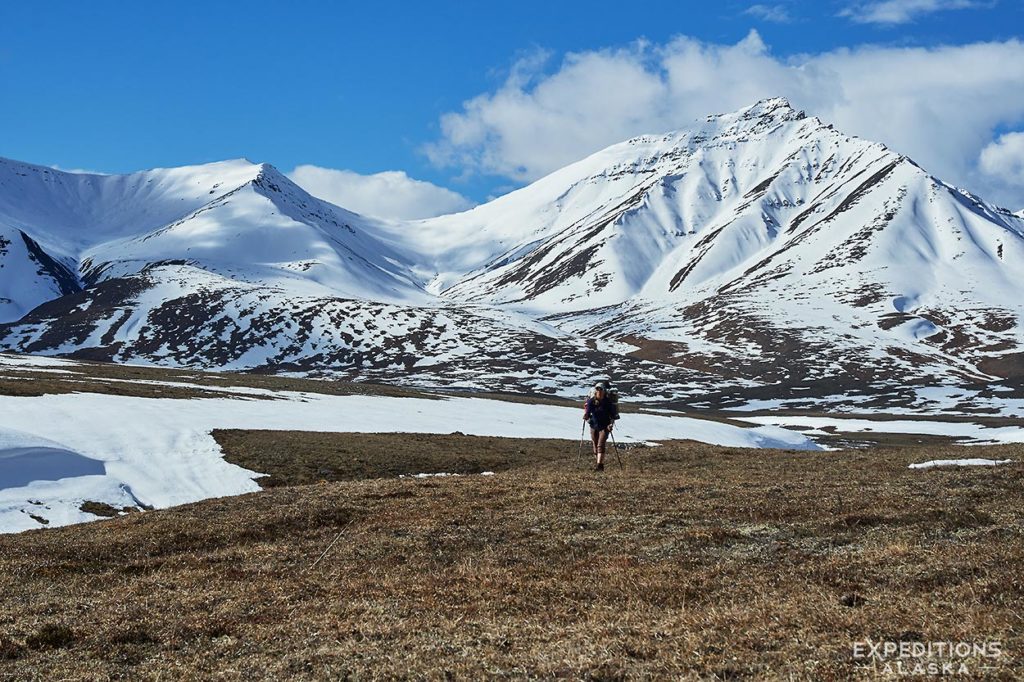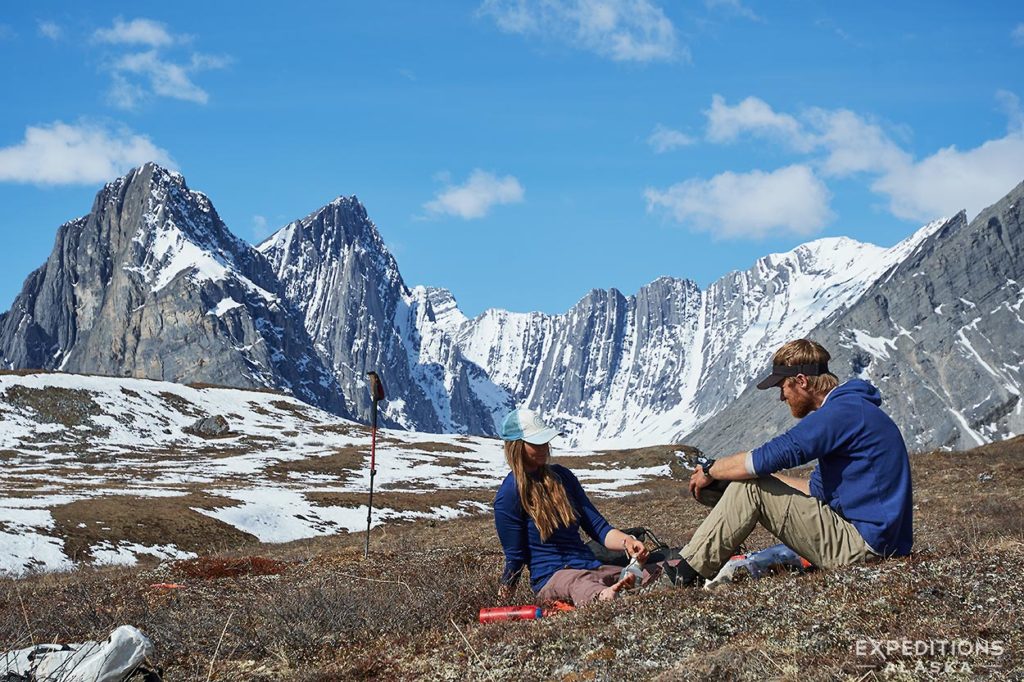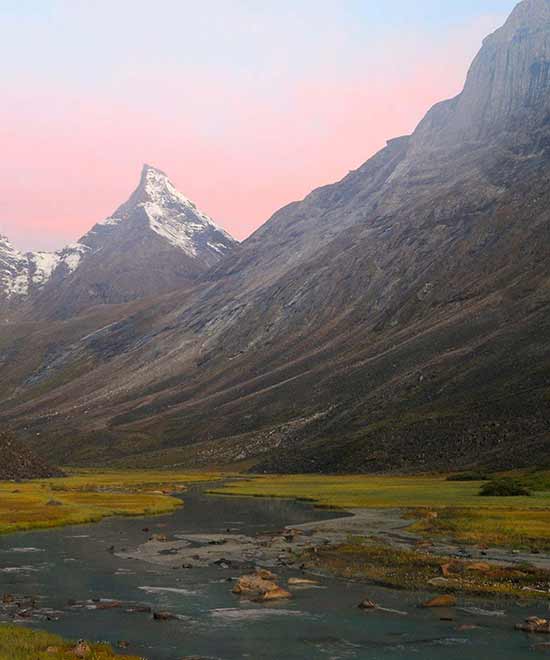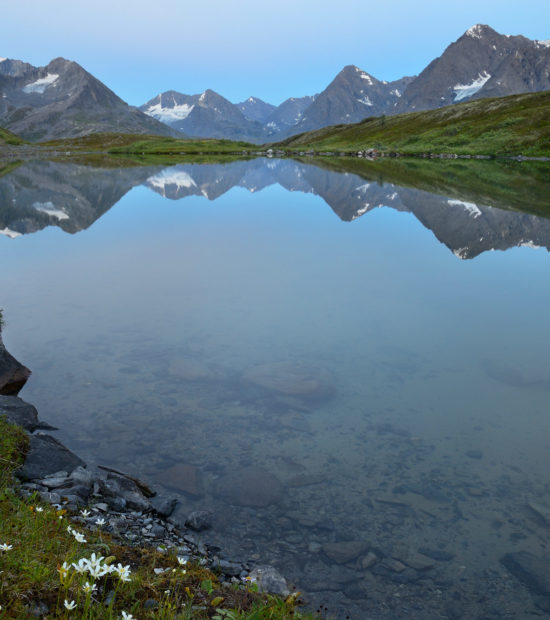Backpacking in the Brooks Range
Backpacking The Brooks Range is always a treat.
The mountains seemingly roll on forever, and the stupendous views belie distances somewhat unfathomable.
Trailless terrain takes you where you will. Sometimes miles across a valley, and sometimes a few hundred yards to a waterfall or the perfect lunch spot.
A wilderness experience you likely aren’t familiar with unless you’ve been to Alaska before.
We get long summer days in Gates of the Arctic. perfect for exploring a little further, or sitting by camp and saoking up arctic midnight sun for a few hours.
It’s a special place.
Feast your eyes on the characteristic glacially sculpted U-shaped valleys. Geologic anomalies surround you from the macro to the micro.
You’ll witness tremendous evidence of uplift creating shapes you would expect only in Alice’s Wonderland formed and solidified.
This topography is complemented by fossils and gems dating far back. Remind yourself to look up and enjoy the views so as to not get too focused into the rocks beneath each talusy step whilst ascending passes.
Being in the Brooks Range brings you back to an innate human desire to know what is around the next bend. This curiosity is rewarded with grand vistas and welcoming footing to explore and gain the next view!
Is This For You?
Who’s It For?
This is one of our “Expedition Series” trips for solid, experienced backpackers. What do we mean by that? People in good physical condition, with an easy going mindset who can roll with what comes their way. People who have taken multiple weeklong to 10-day offtrail treks before and know what that entails. There’s a difference between heading out on a 3 day backpack over a long weekend and undertaking a 10 day backcountry expedition.
Experienced with offtrail travel isn’t critical, but is something you don’t want to dismiss as irrelevant. It matters. Know what you’re getting into.
We have an array of guests with a wide diversity of fitness and experience levels. This backpacking trip is a match for folks on the definitely on the upper end of that.
Challenges
The arctic tundra can present challenges to even relatively solid hikers. Often what appears to be, and often begins as, miles of simple easy walking is a barrage of tussocks and rocks and other terrain challenges. Those can be tough for folks, mentally and physically.
High mountain passes here can present another issues: scree and talus slopes don’t provide great footing, and are often intimidating to folks unused to traversing terrains like this.
Distances and elevation losses/gains aren’t your concern on these trips. Concern yourself with your ability to walk, well-balanced and easily over uneven footing, with a heavy pack.
Trip Logistics
Expedition Series
Our most challenging series of backcountry adventures for experienced, solid backpackers.
10-14 days long, harder trips that meet the need for adventure.
Not for the novice.
Outline
See the Itinerary Section below for more details, but in short, this is your trip.
-
Overnight in Fairbank (not incl)
Fly to Bettles/Coldfoot, change planes, fly in to the park.
Backpack
Fly to Bettles/Coldfoot, overnight (incl)
Fly to Fairbanks
Overnight in Fbks (not incl)
Extra Stuff
You’ll need to pack a small overnight bag for the night in Bettles/Coldfoot. When we arrive back there after the hike, we can shower and change, etc. Do plan to bring larger duffels and suitcases with a boatload of additional gear. Leave that stuff in Fairbanks. Most hotels etc will easily store your gear for you while you’re gone.
A small overnight bag works well.
Travel meals
We’ll plan on providing a lunch in Bettles or Coldfoot before we fly in to the park. From there afterward all meals will be backcountry meals until we arrive back in Bettles/Coldfoot.
In Bettles/Coldfoot we can eat at the lodge. These meals are not included in your trip price. It’s typically a dinner and breakfast and, depending on our flight times, etc, maybe a lunch the day we return to Bettles/Coldfoot.
Gear tip
Hiking poles. Hiking poles. Hiking poles.
You’ll be glad you did.
Trust me.
Trip FAQs
-
How about the mosquitoes?
It’s the arctic. Bugs can be thick and frustrating. but it’s manageable. Bring yourself bug dope. Wear long-sleeves and pants of bug-proof nylon material. A headnet is advisable. Or schedule it for late June, before the bugs get bad. August is often a nice time to walk in the artic as well, as mosquito numbers decrease this time of year.
-
Temperatures?
It’s the arctic. It can easily be below freezing. It’s also interior Alaska, and can be hot and dry. or cold and wet. Or all the above.
I’m not being dismissive or snide here. The variety in temperatures and conditions in Arctic Alaska, or really anywhere in Alaska, is a huge issue. I’ve had frost in the morning and seen 85 degrees later in the day. I’ve done trips where we didn’t see a cloud, and trips to the same location, same timeframe, where we didn’t see anything clouds.
Wind can be ripping. Dress and shelter appropriately.
-
Do we see a lot of wildlife?
One of the great misundertandings about Alaska wilderness is that there are wild critters behind, or in front of, every rock and bush you’ll encounter. There are not.
We are certainly fortunate to have an array of different species and a healthy ecosystem with most of our native animal populations relatively intact, but population densities aren’t generally high.
The growing season here is so short; just a couple months and then the land once again becomes snow covered for 8-9 months of the year. Food is scarce most of the time.
This means animals that do exist here either travel a lot (caribou migrate further than any other land animal on the planet) or they remain in lower population densities.
You may get lucky and see a herd of caribou wander by, or a wolf pack roll across the tundra, or a wolverine saunter cheekily through camp, etc. But you may not as well.
Enjoy the place.
-
What do our Guides Say About The Northern Traverse?
Trevor, guide and bluegrass musician extraordinaire, has this to say about the Northern Traverse (or, as he likes to call it, the Northern se)

Trevor picking and singing. “The N Trav is a newer trip that we really began to understand this last year.
Waterfalls abound. Caribou, wolverines, wolves, and grizzlies occasionally roam the tundra.
Everything up here seems solitary in the arctic’s vastness.
Depending on your experience, we can transform the difficulty of this route.
One thing is for certain: getting over the passes makes this really worth it. By climbing over the mountains you access some of the route’s most beautiful country.
I kept thinking: this is like prehistoric Switzerland.
That being said, let me explain the passes. They feel like “stair masters” made out of sand. You take one step up and you sink a half step down. The best way up the steep shale slopes is often by going straight up, because zig zagging makes you put in even more effort. The days, mileage-wise, do not have to be long. But there is a lot of up and down. This is the first difficult part of the route.
The second is the weather. The arctic’s scope in what it can hit you with is absurd.
You need to pack for blizzards, and then you might get there and you could be sweating every night in your 20˚F bag. Expect very chaotic weather and high winds. Expect changes in your itinerary because of this.
Take our travel precautions seriously. If you can do that, and if you enjoy going uphill, prepare yourself for some of the most beautiful, remote, country you will ever be a part of in your life. “
-
How big does my backpack need to be?
Way too subjective to be a simple FAQ here. In the interest of keeping this simple, 65L is a good backpack for most of our trips (5-10 days). Anything smaller and you need to have your gear system dialed.
Is it doable to do a 10 day backpacking trip with a 45L backpack? Yes. Does it typically work well? Not at all.
For a more thorough discussion of appropriate backpack size, see this blog post.
-
What gear do I need?
You’ll receive a Trip Departure Packet upon your reservation with a detailed Gear section and a comprehensive Gear Check List for you. Read it carefully and be sure you have the appropriate gear with you. We’ll do a gear review before your trip but you really should contact me with any questions you have before you arrive in AK.
You’ll find tons of information on gear and related stuff on the blog. You’ll find some extensive commentary there about gear and backpacking and hiking trips, etc. Rain gear and keeping dry, down versus synthetic sleeping bags , backpacks, and so forth. I update it reasonably often, so do check out the blog posts for information. Here is a link to The Gear Category on the blog.
In the meantime this should help you get started below.
Bring a sturdy backpacking tent. Lesser ‘car camping’ tents can fail miserably when you need them the most. If you don’t have a tent, or aren’t certain, please inquire with Expeditions Alaska. We’ll rent you a tent if you prefer.
Good rain gear is a must. I recommend a lightweight, gore-tex type shell. A poncho-style rain jacket or shawl is NOT recommended (as in, DO NOT BRING ONE).
A sleeping bag that will keep you warm down to 20deg (F) is what I suggest (or lower). A 32deg (F) bag would be considered bare minimum for most Alaskan summer adventures and I do NOT recommend it. Either synthetic fill bags or down bags are great – you just need to keep them dry. Read more about your sleeping bag here.
Unless you’re booking a fully outfitted trip you’ll need to bring a reliable stove. Bring a reliable stove, preferably one that burns white gas, or Coleman fuel. MSR ‘Whisperlite‘ or similar stoves are great. Remember that with current restrictions on air travel it is illegal to bring fuel onto commercial planes. I can provide fuel for you, available when you arrive in Alaska.
Another stove that’s very popular recently is the Jetboil.
My preference is for long sleeve shirts and full length brushed nylon pants. A mosquito headnet is also recommended for those times when the bugs get gnarly.
Do bring cotton pants, shirt, socks, etc. If you’re confused about this, contact me.
Trekking poles are worth their weight in gold. Don’t head for Alaska without them. Expeditions Alaskan provide these (free) if you like.
Definitely bring sturdy, waterproof boots. Your lightweight day hikers may be fine around town but they are often not durable enough to withstand a multi-day alpine adventure. Alaska Hiking boots info.
A comfortable backpack is required and a system for carrying gear on a dayhike is very handy. Many backpacks have removable tops and these work great. A rain cover that fits your fully loaded pack is a must have!
Another choice for is a small summit pack for dayhikes. I use the Marmot Kompressor. Not requisite but handy to have.
The single most important element of gear is your ability to use it.
Practice with your equipment before heading into the backcountry. Do not wait until you’re miles into the wilderness before you realize your stove doesn’t work or that you don’t know how to set up your tent. Being comfortable with your equipment and how to use it can be paramount to a safe and enjoyable trip.
-
Do you have a Gear Check List?
Oh yeah. Right here
Upon your reservation I’ll also send out a detailed Trip Information Packet with more than enough information on gear to keep you busy. Until then the above check list is a good outline of what you need.
-
How are the difficulty ratings defined?
Well, “defined” probably isn’t the right word. This is Alaska after all. But this an important question to consider.
One boot equals easiest and five boots the most challenging option. Thanks.
As a general rule I’d suggest rating everything here one notch from what you might be used to (assuming you haven’t hiked in Alaska before). If you consider yourself up for an intermediate level hike assume that a trip rated intermediate here will probably be a bit tougher than you’re expecting. Not impossible, but harder than you think.
As I mentioned above, terrain is the biggest factor here and it’s extremely subjective as to what is difficult terrain and what is not.
Some people really struggle walking over a boulder field, and others don’t find it difficult at all. Some people find sidehilling more difficult, or bushwhacking, and so on. But the most common element people struggle with is almost always terrain. Your balance is probably a more important consideration than how miles you run on a treadmill each day in the gym.
One of the best ways to lower a rating is simply give yourself an extra day or 2. Make a 5 day hike a 7 day hike and it’ll much more manageable. Conversely, if you want a challenge give yourself a little less time and you’ll find just about any trip here as challenging as you could want it to be.
Again: please carefully . It’s the boot icon in the sidebar of the trip page.
Thanks.
-
What’s Included – Gates trips?
All multi-day trips (backpacking, basecamping, packrafting, photo tours) out of Fairbanks include transport to/from Fairbanks/Bettles, 1 night accommodations in Bettles, air taxi flights Bettles/The Backcountry, group gear such as cook tents, stoves, fuel, BRFCs, bear spray, etc. Hiking poles are included if you don’t have your own.
We include a satellite phone for emergencies and one backup emergency contact device, such as PLB or Garmin InReach. First aid kits, map and compass included. All guides are Wilderness First Responder Certified.
Storage of your overnight travel gear is limited but available (keep it simple, one small overnight bag).
Outfitting of equipment such as tents is available. Expeditions Alaska can either fully outfit your trip (all food, tents, etc) or adjust things a la carte if needed.
Guide gratuities are not included but most appreciated. Trip insurance is not included. I strongly encourage you to buy it on your own. Travelex is who we steer people toward.
For a full outline of What’s included/not included, please see this page
-
What’s A Fully Outfitted Trip Involve?
That is trip dependent.
For backpacking trips, a fully outfitted option includes your tent (one or two person tent), all your kitchenware, food and cooking by Expeditions Alaska. A typical trip, up to 12 days long, costs an additional $450.00 per person for the fully outfitted option ($350 for 4 day trips or shorter).
Available “á la carte” options are (per person)
Tent $50.00/tent
Food/cooking $325.00 (up to 4 day trip duration)
Food/cooking $425 (any trip 5 days or longer)For personal items such as a backpack, or sleeping pad, talk to me prior to your trip and we’ll see if we can possibly arrange something. If you need a pack I recommend you rent a backpack from a reputable local outfitter. They can find and fit a pack to you rather than “making do” with one of mine that may or may not be a good fit for you.
Items such as BRFC, bear spray, fuel, hiking poles are included gratis with Expeditions Alaska trips. See What’s Included? for more info.
-
What comes with the Food Add-on?
If you’d like, Expeditions Alaska can handle your backcountry food for the trip. Cost depends on trip length, but it’s typically $325 for a 2-4 day trip, and $425 for a trip 5 days or longer (backcountry days).
We will organize and pack the food, handle all backcountry prep, as well as pots and pans, the stove/s, fuel and your mess kit. Assistance for cleanup and dishes is always appreciated, but not requisite.
NB: this means, if we’re doing food for your trip, you must arrive with requisite space in your backpack for your share of the food. This typically means a BV500, sized 8.7 in. diameter. (22.1cm) x 12.7 in. (32.3cm) height. There’ll also be your mess kit (cup, bowl, cutlery, etc) and maybe some additional group gear, whether it’s a fuel bottle, stove or pan or skillet. In general your guide will carry the bulk of this stuff, but we certainly can’t and don’t intend to carry all of it. So don’t arrive with a backpack packed full, no space left in it, if we’re doing your food for you. Your food goes in your pack.
More info linked on the page below.
All your questions about our backcountry food answered right here.
-
I Have More Questions
I know you do. I do as well.
I recommend starting with the General Trip FAQ page
More questions? Email me or call me and we’ll go through them.
Upon your reservation I’ll also send out a comprehensive trip information packet that covers just about everything and more you might imagine about your trip.
Where Are We?
Sample Trip Itinerary
As with all our backcountry trips, these itineraries aren’t meant, ever, to outline your day to day experience. There are simply too many factors that shape that each day. We need to be fluid and ready to adapt to those conditions as they arise (as well as do what we can to see them doing). So don’t take this as set in stone itinerary. It isn’t. It’s a tentative outline of the basics. I can’t over-emphasize that this is simply an example.
Rather, what we do here is outline your travel plans and give you a sense of the time frame for your trip. That declared, read on.

